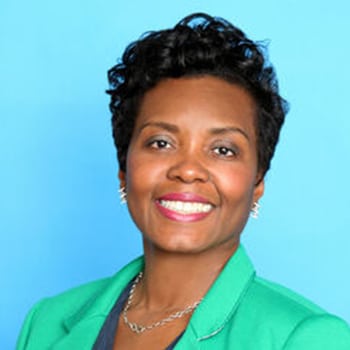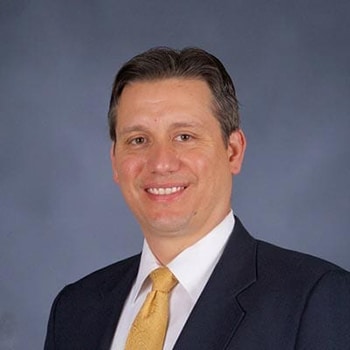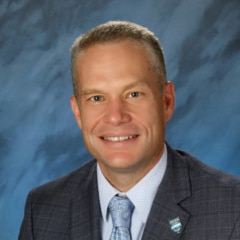Organizing Your
COVID Funds
Superintendent
Highline Public Schools

A high school English, journalism and ELL teacher, Susan served as Chief Academic Officer and then as Interim Superintendent for Seattle Public Schools before coming to Highline in 2012. She previously held leadership positions in Evergreen Public Schools (Vancouver, WA), Portland Public Schools and the Pennsylvania Department of Education.
Susan is a graduate of the University of California, Berkeley, and earned master’s degrees from Stanford University and Harvard University. She also holds a doctoral degree in Administration, Planning and Social Policy from Harvard’s Urban Superintendents Program.
Dr. Carpenter: Susan Enfield from a practitioner’s standpoint let us hear from you. It’s always an honour to work alongside you.
Dr. Susan Enfield: Good morning Dennis. Good to see all of you and I really want to thank you for hoisting this. Part of the impetus for this conversation was Dennis seeing me get a little riled up over the narrative that we as superintendents just had no idea how we were going to spend all these dollars and could someone come in and help save us from ourselves. And I just found that particularly offensive. I know how to strategically use my resources. But I think there are some – but we have to under the strategy and we have to acknowledge I think both the benefits, the opportunities and the challenges of this influx of money that we’re seeing. So Dennis thanks for organizing this. So first of all building on the theme from the prior conversation around focussing on assets and strengths versus deficits I think we need to continue that as we talk about how want to use these dollars.
So I’m looking at this from sort of three categories if you will – (1) short-term triage (2) long-term impact, and (3) ongoing R&D and improvement based on lessons learned over the past year and a half. That’s the way we’re talking about organizing our money. And I do want to build on what Bob said around yes the Chiefs for Change toolkit spreadsheet is very helpful and we are using that in Highline as we have our prioritization conversation. So I’ll talk a little bit about how we are approaching using the influx of money that we are getting here in Highline. And I will begin by saying, you know, I describe our children in Highline as brilliant, beautiful and brimming with promise. I think we should always talk about and with our children from an asset perspective.
And roughly seven in 10 of the almost 18,000 children that we serve in Highline rely on us for their meals, so are what you would call a very high-poverty district. But I don’t lead with that, I lead with the brilliance and beauty and promise of our children. So that means though however that we are getting a significant, have received and will continue to receive a significant amount of these ESSER dollars because it’s being driven out through a Title I formula. So obviously as the superintendent with the responsibility to not only serve children and families but be a good steward of public dollars. We’re figuring out how do we go about this from a very thoughtful strategic standpoint. So he’s how we have approached it. I’ll take bucket 1, short-term triage.
So we are obviously looking at the providing rich summer learning experiences for students this year many of whom – and by the way I am located just outside Seattle Washington where we have been very slow, very, very slow to return our children back into their school buildings. My middle and high school students have only been physically back in their buildings for about three weeks. They had not set foot in their schools since March of 2020. And at this point roughly only 45% are choosing to come back in-person. So we’ve, our children have been disconnected physically from their schools for quite some time. So when we look at what the short-term triage needs to be we’re looking at things like for example hiring more counsellors and providing more teletherapy opportunities because I’ll be very frank.
I’m less worried about the academic challenges that perhaps our students are facing versus the social emotional challenges that our students are facing based on what I hear from the young people that I talk to and what frankly what we are all reading and seeing from across the nation; so building up those social emotional supports through counsellors and others. Now here’s the trick though and I know I’m not telling my colleagues here anything they don’t know, these are one-time dollars and you cannot commit ongoing salary costs with one-time dollars unless you are confident that you’ll be sitting on a pile of cash for the next decade moving forward. So when I say triage we’re looking at hiring some two to three year positions and they will be specifically contracted as two to three year positions to help come in and provide that intense support that we believe some of your students, staff and families will need.
I will add though that we’re also, we’ve also posted for a director of COVID recovery. Again a time-limited position, who is going to essentially function as a project manager if you will to make sure that all of these immediate needs we’ve identified and these investments we’ve made to triage and get ourselves back on track, that we’re doing that well and that it’s coordinated so it doesn’t fall on someone on my cabinet and then, you know, they’re already overwhelmed and things get dropped. So those are some ways in which we’re going to address that first bucket of short-term triage. Now long-term impact, you know this is where we really do have to be strategic and think about what are the investments we can make that will yield results for children and families in community over time.
So one of those for us has been investing in high-quality curriculum materials, so we have been able to use some of this investment to get a really high-quality language arts curriculum which we were sorely needing, into the hands of our staff and students K12. We’re doing other things too around academics and support. But here’s the other thing that I’m not sure we’re talking enough about. I believe strongly that school systems, yes first and foremost have a responsibility to educate and serve our children and our families. But we also have to be part of creating a thriving local economy in our communities and our communities are hurting, so one of the things that we are going to do in Highline is meet with our trusted local community-based organizations and see how we can contract with them to help us do more authentic, more impactful community and family engagement.
Because we know they do it better than we do, let’s just be honest, they do. And if we can contract with them we’re investing in their capacity and their livelihood and that strengthens our community overall. So we’re going to bring together some key leaders in our community and talk with them about, you know, here’s Susan’s crazy idea help make it a good idea [laughs]. Tell us how we can turn this into a system that will benefit all of us. Additionally, you know, we are almost never in a position where we have dollars that we can say to community, “What do you want to do with these?” right, because our dollars are always, they always come with strings. So we are setting aside somewhere between 2% and 5% of our ESSER III dollars for a community-driven fund.
And we are going to bring together community-members, family, staff, students, saying “What kind of investments do we need to make in our children and community? We want to hear from you, we actually have money here that is to some degree unfettered.” Now I want to be clear we can’t just go off and do anything, and you know, I’m not going to go do crazy stuff but we have an opportunity to truly authentically engage with community to determine how we invest these dollars so that we can have a tremendous impact on our children, families and community, and I so don’t want us to squander that opportunity. And those are the kind of investments that I believe will have long-term impact. And then finally thinking about ongoing R&D, ongoing lessons learned, you know.
This is where I want us to be thinking about what are some of the things that we’ve always wanted to do that we haven’t done for all of the reasons that we give, it’s too hard, we can’t because, because, because. We’re going to look at things like changing our high school schedule and what the high school experience looks like for students. We are going to look at, I hope, please Jesus, can we please, please, please start talking about an extended school year that moves away from the agrarian calendar. Sadly that’s not something that a single district I believe can do alone, that has to be a broader regional conversation. But those are the kinds of things I think that we need to be talking about on an ongoing basis. And I will close with this Dennis because I’m sure I’m over time, but I will close with this.
I also think that we have to use this as an opportunity to educate our communities on how school funding works because here is the challenge, there are – this opportunity as wonderful as it is will not without its challenges. (1) I’m going to have to run an operations levy in the fall and that operations levy pays for the bulk of my nurses, school counsellors, psychologists that the state does not fund. I’m going to have to run that levy while I’m receiving tens of millions of dollars from the feds. That’s a tough message for your community top grapple with. So wait I have to raise my taxes for this but you’re getting all this money. So I think we’ve got to talk about a national conversation to help the general public understand the constraints within which we work when it comes to spending dollars and investing in staff.
And secondly, and my good friend, colleague and mentor Steve Joel, superintend in Lincoln Nebraska said this, you know, “You know we need to be mindful of the potential backlash here. We are getting a tremendous investment and I believe our families and community rightfully so will want a return on that investment that they can see and feel when it comes to the quality of their children’s education.” So we are going to have to show that we are getting the job done in a way that perhaps we haven’t in the past. And I think that warrants conversation as well and I will leave it there.
Note: The following text is transcribed from the event audio. It’s largely accurate, but in some cases it may be a bit off due to inaudible passages or transcription errors. It’s intended as an aid to understanding the event, but it shouldn’t be treated as an authoritative record.




